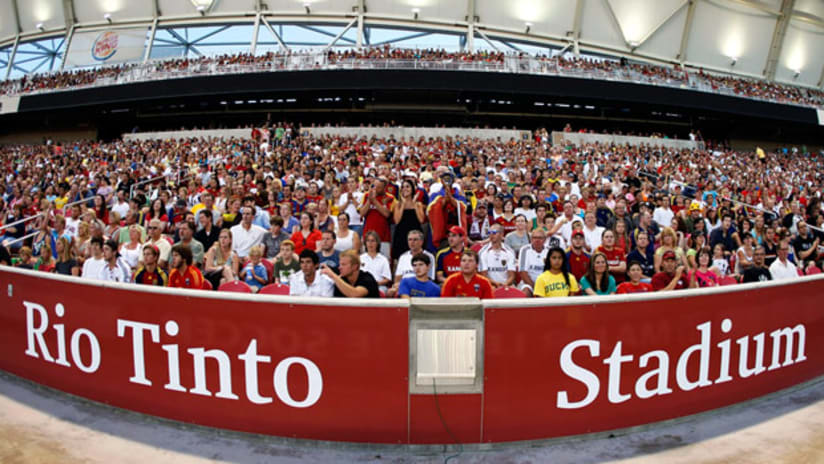Every year, there’s plenty of debate over the MLS Cup Playoffs format. One topic that frequently comes into play is how much to reward the top teams, which inevitably includes discussions of home-field advantage. But just how much of an advantage has playing at home in MLS been? Obviously, home teams have an edge, but how does that translate into numbers?
Let’s take a look.
Home field advantage (HFA) data for MLS
<strong>Year</strong> |
<strong>Games</strong> |
<strong>W</strong> |
<strong>L</strong> |
<strong>D</strong> |
<strong>Home PPG</strong> |
<strong>Away PPG</strong> |
<strong>HFA</strong> |
1996 |
160 |
84 |
42 |
34 |
1.79 |
1.00 |
0.79 |
1997 |
160 |
81 |
46 |
33 |
1.73 |
1.07 |
0.66 |
1998 |
192 |
101 |
58 |
33 |
1.75 |
1.08 |
0.67 |
1999 |
192 |
80 |
55 |
57 |
1.55 |
1.16 |
0.39 |
2000 |
192 |
105 |
53 |
34 |
1.82 |
1.01 |
0.81 |
2001 |
158 |
83 |
47 |
28 |
1.75 |
1.07 |
0.68 |
2002 |
140 |
77 |
41 |
22 |
1.81 |
1.04 |
0.77 |
2003 |
150 |
71 |
38 |
41 |
1.69 |
1.03 |
0.66 |
2004 |
150 |
72 |
32 |
46 |
1.75 |
0.95 |
0.80 |
2005 |
192 |
92 |
56 |
44 |
1.67 |
1.10 |
0.56 |
2006 |
192 |
92 |
44 |
56 |
1.73 |
0.98 |
0.75 |
2007 |
195 |
91 |
54 |
50 |
1.66 |
1.09 |
0.57 |
2008 |
210 |
106 |
47 |
57 |
1.79 |
0.94 |
0.84 |
2009 |
225 |
107 |
49 |
69 |
1.73 |
0.96 |
0.77 |
2010 |
240 |
116 |
66 |
58 |
1.69 |
1.07 |
0.63 |
<strong>Total</strong> |
<strong>2748</strong> |
<strong>1358</strong> |
<strong>728</strong> |
<strong>662</strong> |
<strong>1.72</strong> |
<strong>1.04</strong> |
<strong>0.69</strong> |
This shows the W-L-D records of home teams during the regular reason. For comparison purposes, games that went to a shootout (1996-99) were counted as draws.
Home teams have won 49.4 percent of the time, against 26.5 percent losses and 24.1 percent draws. If draws are counted as half a win and half a loss, then home teams have a .615 winning percentage.
This translates to 1.72 points per game (PPG) for home teams and 1.04 PPG for away teams. So home-field advantage in MLS (the last column) is worth about 0.69 points per game.
To put that in perspective, if a team played its entire 34-game schedule at home, it would end up with 23 more points compared to one who played all 34 games away. An average team (which is 1.38 PPG) playing solely at home (1.72 PPG) would’ve finished in the top three of the MLS standings in most years.
Here’s a chart for home/away goals, per game:
<strong>Year</strong> |
<strong>Goal</strong> |
<strong>Home</strong> |
<strong>Away<br></strong> |
<strong>Difference</strong> |
1996 |
3.37 |
2.01 |
1.36 |
0.64 |
1997 |
3.26 |
1.89 |
1.38 |
0.51 |
1998 |
3.57 |
2.04 |
1.53 |
0.51 |
1999 |
2.86 |
1.59 |
1.27 |
0.32 |
2000 |
3.19 |
1.83 |
1.36 |
0.47 |
2001 |
3.28 |
1.88 |
1.41 |
0.47 |
2002 |
3.01 |
1.76 |
1.25 |
0.51 |
2003 |
2.89 |
1.65 |
1.23 |
0.42 |
2004 |
2.61 |
1.56 |
1.05 |
0.51 |
2005 |
2.87 |
1.59 |
1.28 |
0.32 |
2006 |
2.62 |
1.53 |
1.09 |
0.43 |
2007 |
2.66 |
1.52 |
1.13 |
0.39 |
2008 |
2.81 |
1.69 |
1.12 |
0.57 |
2009 |
2.54 |
1.51 |
1.03 |
0.48 |
2010 |
2.46 |
1.43 |
1.03 |
0.40 |
<strong>Total</strong> |
<strong>2.91</strong> |
<strong>1.68</strong> |
<strong>1.23</strong> |
<strong>0.46</strong> |
With a per-game difference of 0.46, home teams have scored 57.9 percent of all the goals in MLS history. That’s fewer than the winning percentage (.615) might suggest.
Comparison to EPL/other sports
<br> |
<strong>HFA</strong> |
<strong>Win PCT<br></strong> |
<strong>Home Goals<br></strong> |
MLS |
0.69 |
0.615 |
57.9 percent<br> |
EPL |
0.61 |
0.601 |
58.2 percent<br> |
Over the past 15 seasons, the English Premier League has seen a slightly smaller home-field advantage than MLS (0.61 PPG vs. 0.69). This is likely due to the fact that there’s been less parity as well as possibly the smaller amount of travel English teams have to endure.
Despite this, the home goal percentage is very similar.
There’s a Harvard study which concluded that EPL home-field advantage actually increases slightly with the size of the crowd; it would interesting to see if a similar effect exists in MLS.
However, it’s not just soccer. Home-field advantage is important throughout professional sports. Compared with other American sports leagues, the MLS winning percentage for home teams is a bit higher (though it’s hard to directly compare when soccer games have three outcomes). The other big leagues have home winning percentages historically ranging from 54-60 percent, with MLB at the low end and the NBA at the high end.
Regular season vs. playoffs
Though it’s a smaller sample size (187 games), the home-field advantage in MLS Cup Playoffs games has been much greater than in the regular season.
<strong>Year</strong> |
<strong>Games</strong> |
<strong>W</strong> |
<strong>L</strong> |
<strong>D</strong> |
<strong>Home PPG</strong> |
<strong>Away PPG</strong> |
<strong>HFA</strong> |
1996 |
16 |
10 |
3 |
3 |
2.06 |
0.75 |
1.31 |
1997 |
13 |
7<br> |
4 |
2 |
1.77 |
1.08 |
0.69 |
1998 |
13 |
6 |
3 |
4 |
1.69 |
1.00 |
0.69 |
1999 |
15 |
11 |
2 |
2 |
2.33 |
1.53 |
1.80 |
2000 |
16 |
12 |
2 |
2 |
2.38 |
1.50 |
1.88 |
2001 |
17 |
11 |
3 |
3 |
1.13 |
1.71 |
1.41 |
2002 |
17 |
10 |
4 |
3 |
1.94 |
0.88 |
1.06 |
2003 |
10 |
6 |
2 |
2 |
2.00 |
0.80 |
1.20 |
2004 |
10 |
7 |
1 |
2 |
2.30 |
0.50 |
1.80 |
2005 |
10 |
4 |
2 |
4 |
1.60 |
1.00 |
0.60 |
2006 |
10 |
5 |
4 |
1 |
1.60 |
1.30 |
0.30 |
2007 |
10 |
7 |
None |
3 |
2.40 |
0.30 |
2.10 |
2008 |
10 |
4 |
2 |
4 |
1.60 |
1.00 |
0.60 |
2009 |
10 |
6 |
1 |
3 |
2.10 |
0.60 |
1.50 |
2010 |
10 |
5 |
4 |
1 |
1.60 |
1.30 |
0.30 |
<strong>Total</strong> |
<strong>187</strong> |
<strong>111</strong> |
<strong>37</strong> |
<strong>39</strong> |
<strong>1.99</strong> |
<strong>0.80</strong> |
<strong>1.19</strong> |
W-L-D breakdown is 59.4 percent wins, 19.8 percent losses and 20.9 percent draws (a .698 winning percentage compared with .615 in the regular season). The home-field advantage in playoff games is 1.19 PPG, much higher than the 0.69 PPG in the regular season. Meanwhile, home playoff teams have scored 64.8 percent of the goals (vs. 57.9 percent regular season).
The two new opening-round playoff games in 2011 will be single elimination. Previously, MLS has had 18 single-elimination playoff games with a home-field advantage (16 conference championships since 2003, and the 1997 and 2002 MLS Cups). Two-thirds of the home teams have advanced (12/18 = .667), which is close to that .698 all-time percentage.
Unbalanced schedules
One way to use this information as an MLS fan is when considering the unbalanced schedules that teams are often forced to play. For example, this year Sporting Kansas City will embark on a 10-game road trip to start the season while they await the opening of LIVESTRONG Sporting Park. It’s comparable to the trips taken by Columbus (1999), Los Angeles (2003) and Chicago (2006) before their stadiums were completed.
With 10 away games to start the season, a losing record should be expected for KC at that point. If they’re an average team (1.04 away PPG), then they should have 10 points. This season, with the expanded playoffs, a mid-table finish of ninth or 10th out of 18 teams will be good enough to qualify for the postseason.
So, 10 points in 10 games for KC will mean that they’re on track for a playoff berth, even though the overall record might be poor.
Looking at some of the other schedules, Colorado and Los Angeles will start off with more away games, while Dallas, Houston, Real Salt Lake, Toronto and Vancouver will enjoy a large percentage of the early games at home. That’s a key factor to remember when looking at the standings.











